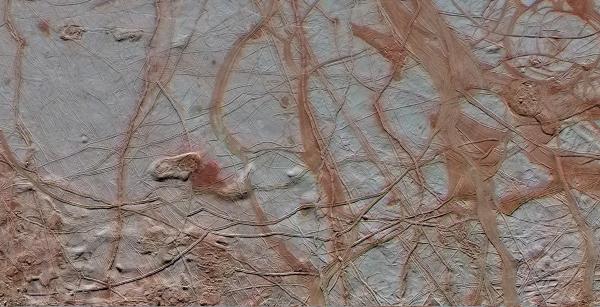Jupiter Moon Europa's Possibly Porous Surface Could Doom a Lander

Putting a lander down on Jupiter's potentially life-supporting moon Europa could be even trickier than engineers had thought.
Europa's surface may be extremely porous, so any probe that touches down there might run the risk of sinking into a sort of extraterrestrial quicksand, a new study suggests.
In the lab, study team members measured the reflectance properties of various configurations of aluminum oxide powder — a good analog, they said, for the material on the surface of bright, airless bodies such as Europa, which harbors an ocean of liquid water beneath its icy shell. [Jupiter's Icy Moon Europa in Pictures]
They found that powder composed of very small particles with lots of space between them — material less dense than freshly fallen snow, team members said — shared several key reflectance characteristics with the actual Europan surface.
But the new study is far from the last word on the subject, study team members said.
"Of course, before the landing of the Luna 2 robotic spacecraft in 1959, there was concern that the moon might be covered in low-density dust into which any future astronauts might sink," lead author Robert Nelson, a senior scientist at the Planetary Science Institute in Tucson, Arizona, said in a statement. "However, we must keep in mind that remote visible-wavelength observations of objects like Europa are only probing the outermost microns of the surface."
NASA has Europa in its sights: The agency is developing a flyby mission to the icy moon, which is expected to launch sometime in the 2020s. This probe, known as Europa Clipper, will study the satellite's buried ocean and assess its habitability using a variety of instruments.
Get the Space.com Newsletter
Breaking space news, the latest updates on rocket launches, skywatching events and more!
Congress has also instructed NASA to get a lander down on Europa. The agency's current thinking calls for launching a surface probe separate from Clipper.
The new study appears in the March 1 issue of the journal Icarus.
Follow Mike Wall on Twitter @michaeldwall and Google+. Follow us @Spacedotcom, Facebook or Google+. Originally published on Space.com.
Join our Space Forums to keep talking space on the latest missions, night sky and more! And if you have a news tip, correction or comment, let us know at: community@space.com.

Michael Wall is a Senior Space Writer with Space.com and joined the team in 2010. He primarily covers exoplanets, spaceflight and military space, but has been known to dabble in the space art beat. His book about the search for alien life, "Out There," was published on Nov. 13, 2018. Before becoming a science writer, Michael worked as a herpetologist and wildlife biologist. He has a Ph.D. in evolutionary biology from the University of Sydney, Australia, a bachelor's degree from the University of Arizona, and a graduate certificate in science writing from the University of California, Santa Cruz. To find out what his latest project is, you can follow Michael on Twitter.
